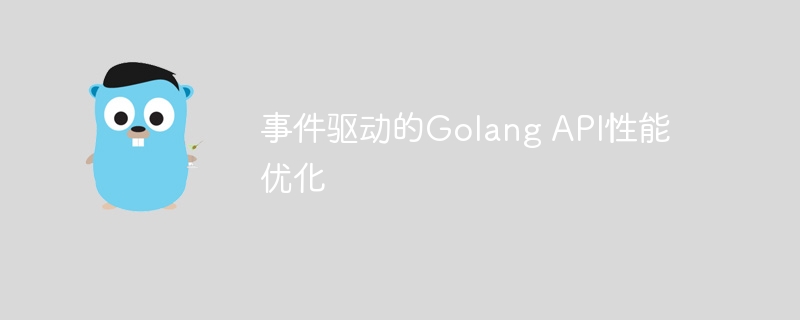
Event-driven Go API performance optimization improves performance in the following ways: Asynchronous non-blocking I/O: Use coroutines and event loops for asynchronous processing to avoid blocking I/O operations. Coroutines and event loops: Coroutines are executed on multiple worker threads, and each worker thread has its own event loop to achieve concurrent processing. Practical case: Asynchronous processing of large data sets, such as image compression and conversion, to improve response time and throughput.

Event-driven Golang API performance optimization
The event-driven programming model can significantly improve when building high-performance APIs Performance of Go language applications. By leveraging coroutines and non-blocking I/O, the API can handle multiple requests simultaneously, maximizing throughput and reducing latency.
Asynchronous non-blocking I/O
The event-driven Go API implements asynchronous operations by using non-blocking I/O. Rather than blocking calls waiting for an I/O operation to complete, non-blocking I/O uses coroutines to schedule tasks into independent event loops, allowing the API to continue performing other tasks.
Code Example
The following code snippet shows how to use sync.WaitGroup and net/http in Go language Package to create a simple non-blocking HTTP server:
import (
"net/http"
"sync"
)
func main() {
var wg sync.WaitGroup
http.HandleFunc("/", func(w http.ResponseWriter, r *http.Request) {
wg.Add(1)
// 异步处理请求
go func() {
defer wg.Done()
// ... 处理请求 ...
}()
})
http.ListenAndServe(":8080", nil)
wg.Wait()
}Coroutines and event loops
Go's runtime schedules coroutines into multiple worker threads, each Each worker thread has its own event loop. Coroutines can execute without blocking the main thread, allowing the API to handle requests concurrently.
Practical Case
A common practical case is asynchronous processing of large data sets. Consider an API that processes user-uploaded images and compresses and converts the images behind the scenes. Traditionally, APIs would perform these operations blockingly, causing performance bottlenecks.
Using an event-driven model, the API can assign image compression and conversion tasks to coroutines, freeing the main thread to continue processing other requests. This greatly improves the response time and throughput of the API.
Conclusion
Event-driven Go API performance optimization provides significant advantages. By leveraging coroutines and non-blocking I/O, you can build high-performance, scalable, and responsive applications that efficiently handle concurrent requests and maximize resource utilization.
The above is the detailed content of Event-driven Golang API performance optimization. For more information, please follow other related articles on the PHP Chinese website!
 How to define variables in golang
How to define variables in golang
 What are the data conversion methods in golang?
What are the data conversion methods in golang?
 What are the commonly used libraries in golang?
What are the commonly used libraries in golang?
 What is the difference between golang and python
What is the difference between golang and python
 Solution to garbled characters when opening excel
Solution to garbled characters when opening excel
 How is the performance of thinkphp?
How is the performance of thinkphp?
 Permanently free oa system
Permanently free oa system
 How to solve tomcat startup crash
How to solve tomcat startup crash




